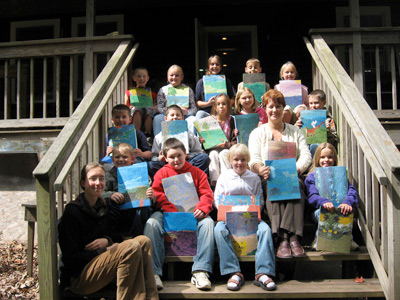Teaching Artist Initiative
Penland School of Craft supports individual and artistic growth through creative practice and discovery.
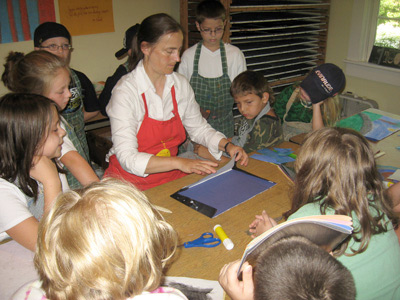 Mission & Guiding Educational Goals
Mission & Guiding Educational Goals
The Teaching Artist Initiative crafts powerful and creative learning experiences for children. We believe that our most important learning is relational – motivated by that for which we have love and curiosity. We implement the following learning skills to connect children to their lives right where they live them, so they can come to know themselves as capable contributors to the many communities of which they are a part.
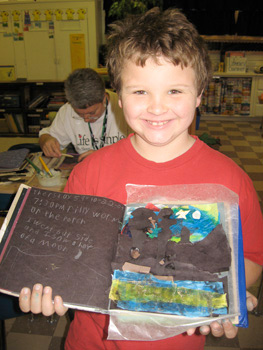 We give students high-quality materials, adequate time to work, and projects that are engaging. We encourage students to “hang in there” with a mistake, reworking it until they’re satisfied. Projects are challenging enough to improve students’ skills and give them a genuine sense of pride in accomplishment.
We give students high-quality materials, adequate time to work, and projects that are engaging. We encourage students to “hang in there” with a mistake, reworking it until they’re satisfied. Projects are challenging enough to improve students’ skills and give them a genuine sense of pride in accomplishment.
“There are lots of steps and they really have to work and concentrate – it’s harder than it looks.” – 4th grade teacher
“The sewing was hard, but it was my favorite part. I liked helping others once I figured it out.” – 4th grade student
“I really like how some people bound their books – the ones with the criss-cross and the braided cord. That’s a lot of work. Some people were really feeling it.” – 10th grade student
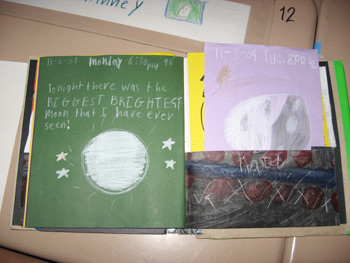 Students and teachers work on individual books, but they learn together in a community that’s encouraging, joyous, patient and flexible. All participants are co-discoverers who inspire each other. Students are thrilled to witness their teachers learning side-by-side with them. Creative inquiry nourishes new respect and empathy between classroom members.
Students and teachers work on individual books, but they learn together in a community that’s encouraging, joyous, patient and flexible. All participants are co-discoverers who inspire each other. Students are thrilled to witness their teachers learning side-by-side with them. Creative inquiry nourishes new respect and empathy between classroom members.
“I was surprised that Ms. K [the teacher] is doing a book too, about her time at this school. I didn’t know she went to school here and that she was a basketball star.” – 10th grade student
“I was surprised by the participation of the whole family.” – 3rd grade teacher
“The more we got into it the more we started to learn about each other.” – 10th grade student
“I enjoyed watching kids make decisions about working alone or in groups on their research. They were comfortable working both ways.” – 4th grade teacher
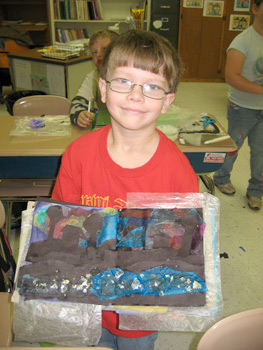 Imagination is called into play with worthy questions and inspiration. Students need to have a vision of where they are going to begin and where they might go. They also have to be able to change course and receive new imaginings as they travel more deeply into their work; we learn much more from our surprises than from our achieved expectations. No one response is ever solely correct or final.
Imagination is called into play with worthy questions and inspiration. Students need to have a vision of where they are going to begin and where they might go. They also have to be able to change course and receive new imaginings as they travel more deeply into their work; we learn much more from our surprises than from our achieved expectations. No one response is ever solely correct or final.
“I like this collage – how I put the mountains together. I tried to find blue paper for the river but there was none left so I used mica.” – 3rd grade student
“I was just playing around one time and mixed up ALL the colors – and I got a painting of trees in a midnight sky.” – 3rd grade student
“I was going to paint a beach but I didn’t like how it was turning out so I smeared it all together. I liked how it looked so I kept it and it ended up being my favorite.” – 10th grade student
“I like the way I did the mountains in this picture. I put glue on the front too and it made it a little shiny.” – 3rd grade student
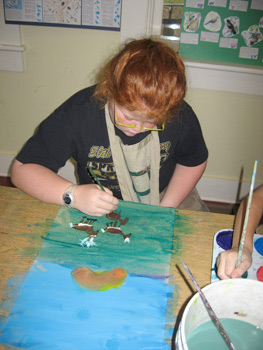 Reflection, working memory, flexible thinking, sequencing, careful choice-making, pattern identification – these are some of the thinking skills that are practiced through making a book and self-directing the learning documented in it. Following one’s own questions, reflecting on one’s actions and wisely applying information and instructions are essential life skills embedded in each student’s experience.
Reflection, working memory, flexible thinking, sequencing, careful choice-making, pattern identification – these are some of the thinking skills that are practiced through making a book and self-directing the learning documented in it. Following one’s own questions, reflecting on one’s actions and wisely applying information and instructions are essential life skills embedded in each student’s experience.
“Take time to think before coming to paint and while you’re working in your book.” – advice from a 4th grade student for next year’s class
“There were a lot of directions to follow for making the cover of the nature journal.” – 3rd grade student
“It was hard to know what to write when we didn’t have a specific assignment every night.” – 3rd grade student
“It was hard to know what to write when we didn’t have a specific assignment every night.” – 3rd grade student
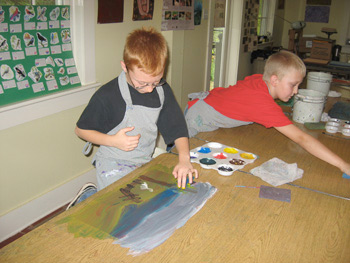 Wonder is the threshold through which personal commitment arises. Brains work better in safe, joyful classrooms. We ask students to take close notice of the world around them and to celebrate their attention. Satisfaction with one’s work is one of life’s greatest gifts; those who enjoy learning will be lifelong learners.
Wonder is the threshold through which personal commitment arises. Brains work better in safe, joyful classrooms. We ask students to take close notice of the world around them and to celebrate their attention. Satisfaction with one’s work is one of life’s greatest gifts; those who enjoy learning will be lifelong learners.
“When you’re creating art you learn just what a mind God has.” – 4th grade teacher
“I saw a fingernail moon and I could see the outline of the whole moon too – the teacher hadn’t told us about that!” – 3rd grade student
“I never worked on such a big project before. I’m proud to have a book of my own that I can look back at and remember fourth grade.” – 4th grade student
“Some days I was even looking forward to coming to class to work on this book.” – 10th grade student
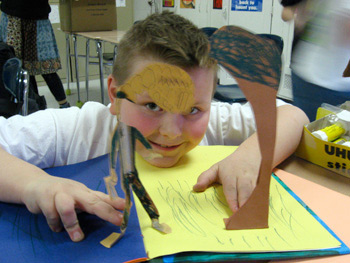 We believe in the embodiment of learning through multiple layers of engagement. The more layers of our humanity (our senses, intellect, body, emotions, spirit) that are attending to the task at hand, the more we gain from any experience. The physicality of art materials and the emotional investment we bring to art-making results in powerful learning of personal significance for each child.
We believe in the embodiment of learning through multiple layers of engagement. The more layers of our humanity (our senses, intellect, body, emotions, spirit) that are attending to the task at hand, the more we gain from any experience. The physicality of art materials and the emotional investment we bring to art-making results in powerful learning of personal significance for each child.
“It was hard to get to sleep after working in my Moon Journal because I was still thinking about what I saw.” – 3rd grade student
“I liked the sound of the scratching on the scratchboard.” – 3rd grade student
“I like my pop-up because it shows who I am.” – 4th grade student
“I don’t really like school because I’m not good at it, but I did like this project. I don’t know what I’m going to do about the poems and stuff but making the books and doing the paintings let me show who I am.” – 10th grade student
Students are afraid of taking risks because they’re afraid of failure. But without taking risks they can’t challenge themselves – they can never really succeed. We give them a challenging project in a supportive environment so that they can experience the reward of pushing themselves beyond what they thought they could do – and succeeding. Every child finishes a book.
“I was surprised that I could make my figure pop up. You feel like you just can’t do something and then you find you can!” – 4th grade student
“I was amazed at how compliccated the books are – it’s not just one or two steps to putting them together. I don’t think I would ever would have tried something so complicated.” – 4th grade teacher
“I liked challenging myself to draw new things – like cows.” – 4th grade student
“I was surprised that my classmates thought my work was good.” – 3rd grade student
Teaching Artist in the Schools
As the sole program of its kind in western North Carolina, the Teaching Artist in the Schools program is a model project that integrates the arts into the education and lives of K-12 youth. Penland works in close collaboration with Mitchell County Public School teachers and principals to provide curriculum-integrated arts opportunities to over 500 rurally-based, underserved students in our Appalachian region each year. Assisted by classroom teachers and her teaching artist assistant, Penland’s professional teaching artist Meg Peterson instructs 3rd, 4th, and 10th grade students in how to paint, fold, bind, illustrate, and write in handmade journals and books that support specific units of study.
This facet of the Teaching Artist initiative not only teaches students new artistic skills and means of expression; it supports students and their teachers and principals by engaging multiple learning styles, helping fulfill the NC Standard Course of Study, and enriching school culture by promoting confidence and self-esteem among students of all backgrounds.
